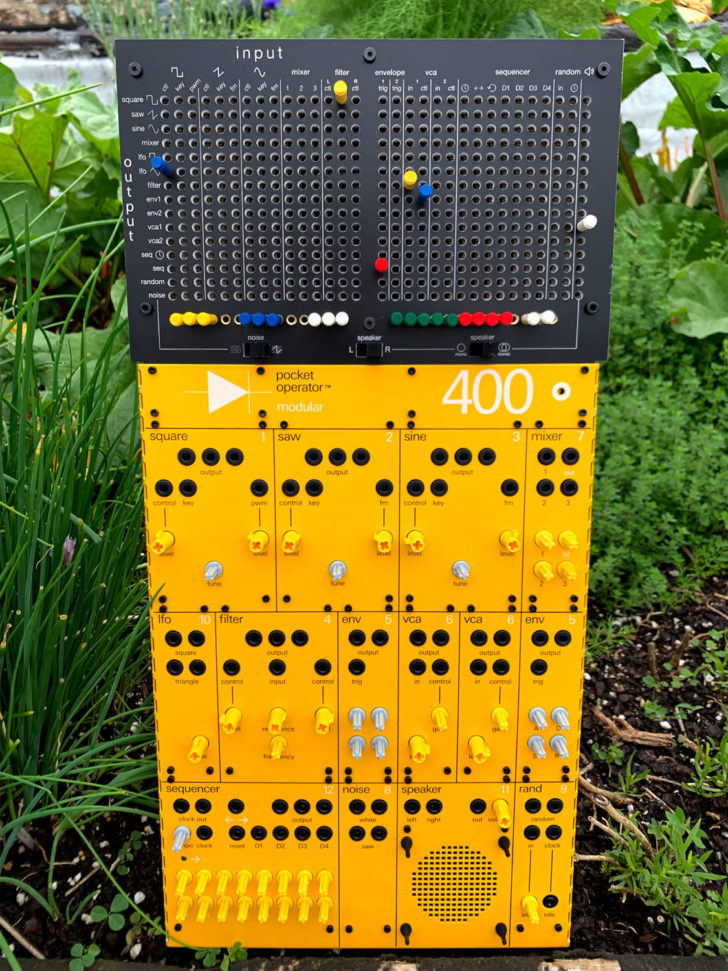Developer Dave Vondle has announced a third-party add-on for the Teenage Engineering Pocket Modular 400 that adds a Synthi AKS style patch matrix.
The Teenage Engineering POM-400 Matrix Kit bolts onto the back of the POM-400 modules, with supplied hardware. Once bolted on, it lets you make all the patches you could otherwise make using cables, with the added benefit of having virtually no restrictions on the number of available outputs and inputs for each module.
Patch cables can still be used in conjunction with the matrix for interfacing the system with external modules and running sound out from the device.
Pricing and Availability
The Teenage Engineering POM-400 Matrix Kit is available for $700 USD.
Vondle notes that “Yes, it’s $100 more than the POM-400 itself but, it’s $14,000 cheaper than a Synthi!” He says that the material costs for the kit are about $650, adding, “I made this because I love the aesthetics, clean look and fun of making patches using the pin matrix, not to make a living from this.”


Holy patchboards, Batman!
If only the 400 sounded good.
This style of patchbay is only theoretically cool.
In reality the inability to control the levels or offsets when doing routing to multiple destinations kills most of the usefulness.
I can’t believe how often this stuff gets promoted and ooooh’d over. People doing that have obviously never used a system with this design. If they had they would instantly see the problem. Man.
I’m assuming the colored pins serve the same function as the colored pins in the synthi: they attenuate the cv. Granted there is limitations in patching this way, but no one complains about a minimoog being monophonic or lacking a high pass/band pass/etc filter. This is a solution to avoid the need for multiples/stackable cables and unity cv/audio mixers.
True. Only the inputs have level controls, can’t balance modulators without output levels too. The illusion of freedom.
“I made this because I love the aesthetics, clean look and fun of making patches using the pin matrix”
multipliers are not the only advantage of a matrix. Cables can’t offset or control levels so there is no disadvantage.
Hi Mr./Ms. Bat
I used a VCS3 and an AKS for decades and did not have much of a problem with attenuating signals routed by the matrix patch system.
I did, and still do, not like the fact that all attenuation on such a system is on the output side of a control module instead of being able to regulate the CV at the input of the module being controlled.
But the good news with this system is, as the article says, “Patch cables can still be used in conjunction with the matrix for interfacing the system with external modules and running sound out from the device.”
Leave it to TE to make the prettiest things. I’d like this as bt midi.
this yellow color hurts my eyes
The 400 looks great. Hopelessly unreliable, noisy, terrible UI, flimsy components that have meant I’ve had to replace two modules. A patch bay will no doubt add some interesting functionality but fundamentally it’s a bit of a toy. But yeah, it looks great. I have a Synthi too, which is built like a tank and sounds like a proper synth, and didn’t cost me £14K. Had to wait seven years for it to be hand built tho.
PAIA was a bit of a toy, but kicked ass for the price.
Please TE get of this modular band wagon and make a OP1 but for professional sound design this time!
With $600 + $700 = $1300 I can buy some serious stuff other than this. No thanks.
$700? isnt that more than the TE 400 itself costs?
He actually gives his parts list. For pins he is using part number GSS 621/15 from ghielmetti dot ch. It’s a “connecting plug” and is a solid connector, no built in resistance/attenuation.
He actually gives his parts list, to show he’s selling them basically at his cost. For pins he is using part number GSS 621/15 from ghielmetti dot ch. It’s a “connecting plug” and is a solid connector, no built in resistance/attenuation. So the connections are at 100%.
These systems could be very nice if the build quality was better …